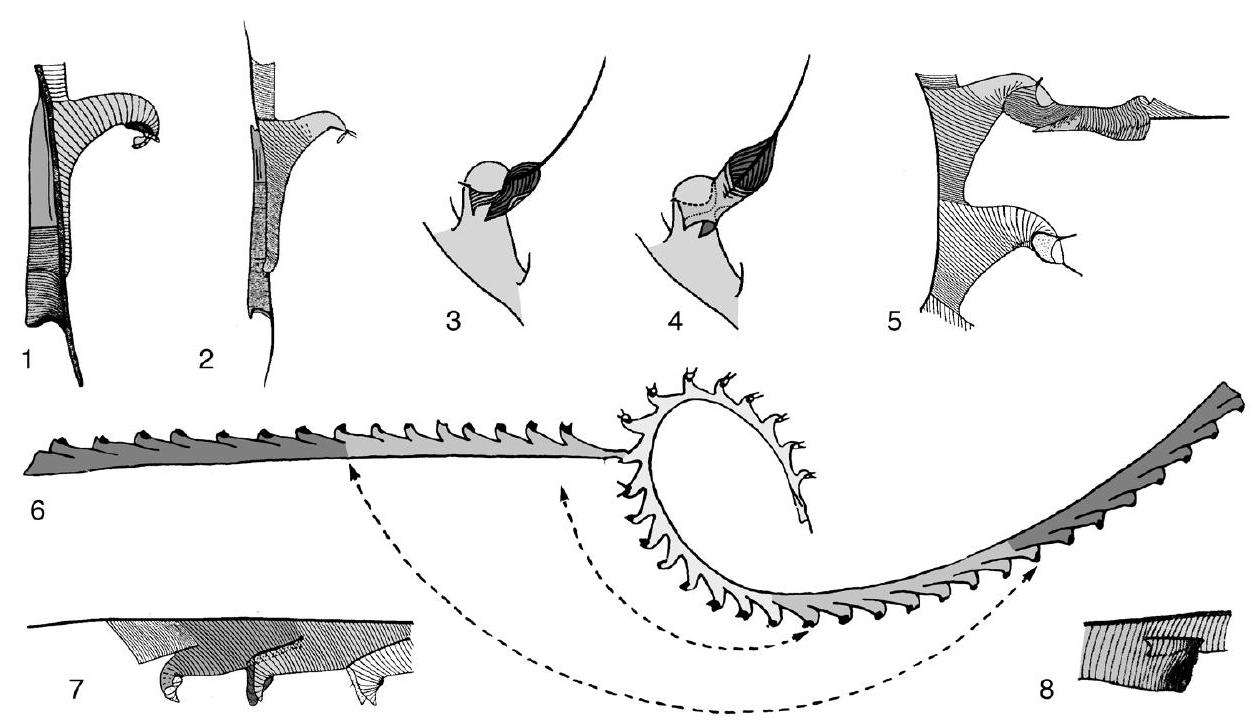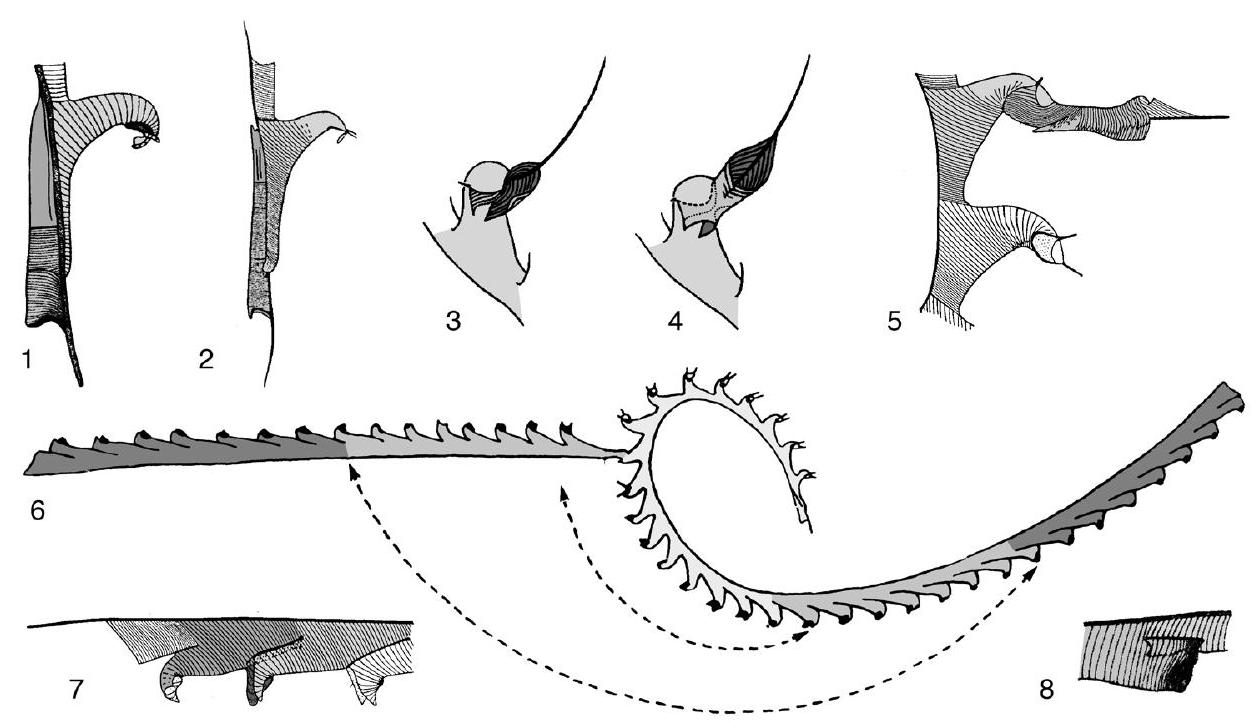Welcome to the Treatise on Invertebrate Paleontology!
Please enter a genera name to retrieve more information.

Cyrtograptus
Classification
Phylum:
Hemichordata
Class:
Pterobranchia
Subclass:
Graptolithina
Order:
Graptoloidea
Suborder:
Axonophora
Infraorder:
Neograptina
Superfamily:
Monograptoidea
Family:
Monograptidae
Subfamily:
Monograptinae - Subset of taxa with cladia
Formal Genus Name and Reference:
Cyrtograptus Carruthers in Murchison, 1867a, p. 540, nom. correct.
Type Species:
C. murchisoni; OD
Images
(Click to enlarge in a new window)
Fig. 302,1a–c. *C. murchisoni, Builth District, Wales; 1a, counterpart of holotype, GSM 10718; 1b, topotype, proximal end, GSM 10716; 1c, topotype, proximal end with sicula, GSM 10716, scale bars, 5 mm, 1 mm in 1b (a–c, Zalasiewicz & Williams, 2008, Atlas, Folio 2.60).——Fig. 302,1d. C. insuetus (Koren’), holotype, scale bar, 5 mm (Rickards, Hutt, & Berry, 1977, fig. 39).——Fig. 302,1e. C. magnificus (Averianow), holotype, scale bar, 5 mm (Obut, 1950, fig. 6).
Synonyms
Cyrtograpsus, Pleurograptoides, Averianowograptus, Damosiograptus, Uralograptus, Kurganakograptus
Geographic Distribution
worldwide
Age Range
Beginning Stage in Treatise Usage:
Silurian, Llandovery (Telychian,
Cyrtograptus lapworthi Biozone)
Beginning International Stage:
Telychian
Fraction Up In Beginning Stage:
0
Beginning Date:
438.59
Ending Stage in Treatise Usage:
Silurian (Wenlock (Homerian,
Cyrtograptus lundgreni Biozone)
Ending International Stage:
Homerian
Fraction Up In Ending Stage:
100
Ending Date:
426.74
Description
Dorsally curved, low helically spiralled or dorsally curved then straight tubarium bearing at least one thecal cladium; thecae of main stipe hooked throughout, often laterally expanded and spinose, or hooked proximally then with hooks retreating distally, becoming hooded initially and then simple tubes with lateral lappets flanking aperture; thecae of thecal cladia hooked, hooded, simple adnate or isolated tubes in some cases with lateral lappets flanking aperture; secondary and tertiary cladia may develop from cladial thecae. [The genus has been considered polyphyletic, e.g.,
Rickards, Hutt, and Berry (1977) and needs re-investigation].
References
Museum or Author Information
Classification
Phylum:
Hemichordata
Class:
Pterobranchia
Subclass:
Graptolithina
Order:
Graptoloidea
Suborder:
Axonophora
Infraorder:
Neograptina
Superfamily:
Monograptoidea
Family:
Monograptidae
Subfamily:
Monograptinae - Subset of taxa with cladia
Formal Genus Name and Reference:
Cyrtograptus Carruthers in Murchison, 1867a, p. 540, nom. correct.
Type Species:
C. murchisoni; OD
Images
(Click to enlarge in a new window)
Fig. 302,1a–c. *C. murchisoni, Builth District, Wales; 1a, counterpart of holotype, GSM 10718; 1b, topotype, proximal end, GSM 10716; 1c, topotype, proximal end with sicula, GSM 10716, scale bars, 5 mm, 1 mm in 1b (a–c, Zalasiewicz & Williams, 2008, Atlas, Folio 2.60).——Fig. 302,1d. C. insuetus (Koren’), holotype, scale bar, 5 mm (Rickards, Hutt, & Berry, 1977, fig. 39).——Fig. 302,1e. C. magnificus (Averianow), holotype, scale bar, 5 mm (Obut, 1950, fig. 6).
Synonyms
Cyrtograpsus, Pleurograptoides, Averianowograptus, Damosiograptus, Uralograptus, Kurganakograptus
Geographic Distribution
worldwide
Age Range
Beginning Stage in Treatise Usage:
Silurian, Llandovery (Telychian,
Cyrtograptus lapworthi Biozone)
Beginning International Stage:
Telychian
Fraction Up In Beginning Stage:
0
Beginning Date:
438.59
Ending Stage in Treatise Usage:
Silurian (Wenlock (Homerian,
Cyrtograptus lundgreni Biozone)
Ending International Stage:
Homerian
Fraction Up In Ending Stage:
100
Ending Date:
426.74
Description
Dorsally curved, low helically spiralled or dorsally curved then straight tubarium bearing at least one thecal cladium; thecae of main stipe hooked throughout, often laterally expanded and spinose, or hooked proximally then with hooks retreating distally, becoming hooded initially and then simple tubes with lateral lappets flanking aperture; thecae of thecal cladia hooked, hooded, simple adnate or isolated tubes in some cases with lateral lappets flanking aperture; secondary and tertiary cladia may develop from cladial thecae. [The genus has been considered polyphyletic, e.g.,
Rickards, Hutt, and Berry (1977) and needs re-investigation].



